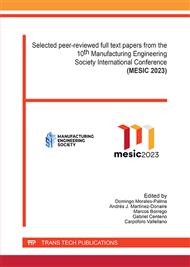[1]
Gallego García, S., & García García, M. (2018). Design and simulation of production and maintenance management applying the viable system model: the case of an OEM plant. Materials, 11(8), 1346.
DOI: 10.3390/ma11081346
Google Scholar
[2]
Gallego-García, S.; García-García, M. Market-Oriented Procurement Planning Leading to a Higher Service Level and Cost Optimization. Appl. Sci. 2020, 10, 8734.
DOI: 10.3390/app10238734
Google Scholar
[3]
Straube, F., & Pfohl, H. C. (2008). Trends und Strategien in der Logistik–Globale Netzwerke im Wandel. Umwelt, Sicherheit, Internationalisierung, Menschen. Hamburg.
Google Scholar
[4]
Schuh, G., & Roesgen, R. (2006). Aufgaben. Produktionsplanung und-steuerung (pp.28-80) Springer.
DOI: 10.1007/3-540-33855-1_3
Google Scholar
[5]
Nyhuis, P.: Wandlungsfähige Produktionssysteme. Gito-Verlag, Berlin 2010.
Google Scholar
[6]
Nyhuis, P., Reinhart, G., & Abele, E. (2008). Wandlungsfähige Produktionssysteme: Heute die Industrie von morgen gestalten. 1. PZH, Hannover
DOI: 10.3139/104.101285
Google Scholar
[7]
Torres, M.B.; Gallego-García, D.; Gallego-García, S.; García-García, M. Development of a Business Assessment and Diagnosis Tool That Considers the Impact of the Human Factor during Industrial Revolutions. Sustainability 2022, 14, 940
DOI: 10.3390/su14020940
Google Scholar
[8]
Winkler, M.; Gallego-García, S.; García-García, M. Design and Simulation of Manufacturing Organizations Based on a Novel Function-Based Concept. Appl. Sci. 2022, 12, 811
DOI: 10.3390/app12020811
Google Scholar
[9]
Johanning, V. (2014). IT-strategie: Optimale ausrichtung der IT an das business in 7 schritten Springer-Verlag.
DOI: 10.1007/978-3-658-02049-1
Google Scholar
[10]
Kirby, C., & Brosa, N. (2011). La Logística Como Factor De Competitividad De Las Pymes En Las Américas
Google Scholar
[11]
Hillebrand, V. (2002). Gestaltung und auswahl von koordinationsschwerpunkten zwischen produzent und logistikdienstleister Shaker.
Google Scholar
[12]
Rouhani, A.; Fazelhashemi, S. Forget about TPM, 1st ed.; Rasa Cultural Services Institute: Tehran, Iran, 2009.
Google Scholar
[13]
Placzek, T.S. Optimal Shelf Availability: Analyse und Gestaltung Integrativer Logistikkonzepte in Konsumgüter-Supply Chains; Springer: Wiesbaden, Germany, 2007.
DOI: 10.1007/bf03249110
Google Scholar
[14]
Capgemini. Customer Back on Top of the Supply Chain Agenda in 2010. from Financial Crisis to Recovery: Does the Financial Crisis Still Dictate Supply Chain Agendas? Capgemini Consulting: Utrecht, The Netherlands, 2010.
Google Scholar
[15]
Bundesverband Logistik BVL. Studie Trends und Strategien in der Logistik 2008: Die Kernaussagen; Frank straube und hans-christian pfhol; Deutscher Verkehrs-Verlag: Bremen, Germany, 2008.
Google Scholar
[16]
Gallego-García, S. (2023). Diseño de un sistema de gestión logístico para la mejora de la adaptabilidad y la sostenibilidad de una organización basado en la Responsabilidad Social Corporativa. Tesis Doctoral (Defensa en fecha 13/03/2023).
DOI: 10.19083/tesis/624863
Google Scholar
[17]
Pfohl, H. Logistiksysteme: Betriebswirtschaftliche Grundlagen; Springer: Berlin/Heidelberg, Germany, 2004.
Google Scholar
[18]
Wiendahl, H. Auftragsmanagement der Industriellen Produktion: Grundlagen, Konfiguration, Einführung; Springer: Berlin/Heidelberg, Germany, 2011.
DOI: 10.1007/978-3-642-19149-7_7
Google Scholar
[19]
Meier, C. Echtzeitfähige Produktionsplanung und-Regelung in der Auftragsabwicklung des Maschinen-und Anlagenbaus; ApprimusVerlag: Aachen, Germany, 2013.
Google Scholar
[20]
Fleisch, E.; Christ, O.; Dierkes, M. Die betriebswirtschaftliche vision des internets der dinge. In Das Internet Der Dinge; Springer: Berlin/Heidelberg, Germany, 2005; p.3–37.
DOI: 10.1007/3-540-28299-8_1
Google Scholar
[21]
Hellmich, K.P. Kundenorientierte Auftragsabwicklung: Engpassorientierte Planung und Steuerung des Ressourceneinsatzes; Springer: Berlin/Heidelberg, Germany, 2003.
DOI: 10.1007/978-3-663-10590-9_3
Google Scholar
[22]
Fischäder, H. Störungsmanagement in Netzwerkförmigen Produktionssystemen; Springer: Berlin/Heidelberg, Germany, 2007.
DOI: 10.1007/978-3-8350-9375-1
Google Scholar
[23]
Shen, W.; Yang, C.; Gao, L. Address business crisis caused by COVID-19 with collaborative intelligent manufacturing technologies. IET Collab. Intell. Manuf. 2020, 2, 96–99.
DOI: 10.1049/iet-cim.2020.0041
Google Scholar
[24]
Dmitry, I.; Dolgui, A. A digital supply chain twin for managing the disruption risks and resilience in the era of Industry 4.0. Prod. Plan. Control. 2020, 1–14.
DOI: 10.1080/09537287.2020.1768450
Google Scholar
[25]
Butt, J. A Strategic Roadmap for the Manufacturing Industry to Implement Industry 4.0. Designs 2020, 4, 11.
DOI: 10.3390/designs4020011
Google Scholar
[26]
Dorfman, M. S. (2002). Introduction to Risk Management and Insurance.
Google Scholar
[27]
Schuh, G.; Brosze, T.; Brandenburg, U.; Cuber, S.; Schenk, M.; Quick, J.; Hering, N. Grundlagen der Produktionsplanung und-Steuerung; Produktionsplanung Und-Steuerung 1; Springer: Berlin/Heidelberg, Germany, 2012; p.9–293.
DOI: 10.1007/978-3-642-25423-9_2
Google Scholar
[28]
Schuh, G. (2016). Management industrieller Dienstleistungen (pp.105-140). G. Gudergan, & A. Kampker (Eds.). Springer Vieweg
DOI: 10.1007/978-3-662-47256-9
Google Scholar
[29]
Mittal, S.; Khan, M.A.; Romero, D.; Wuest, T. Smart manufacturing: Characteristics, technologies and enabling factors. J. Eng. Manuf. 2019, 233, 1342–1361
Google Scholar
[30]
Rouhani, A.; Fazelhashemi, S. Forget about TPM, 1st ed.; Rasa Cultural Services Institute: Tehran, Iran, 2009.
Google Scholar
[31]
Hinckeldeyn, J.; Dekkers, R.; Altfeld, N.; Kreutzfeldt, J. Bottleneck-based synchronisation of engineering and manufacturing. In Proceedings of the International Association for Management of Technology IAMOT 2010 19th International Conference on Management of Technology, Cairo, Egypt, 7–11 March 2010.
Google Scholar
[32]
Negri, E.; Fumagalli, L.; Macchi, M. A review of the roles of digital twin in CPS-based production systems. Procedia Manuf. 2017, 11, 939–948.
DOI: 10.1016/j.promfg.2017.07.198
Google Scholar
[33]
Gallego-García, D. (2021). Diseño conceptual y simulación de la planificación de la producción y gestión de inventarios con un enfoque de MRP: caso concreto para la fabricación de componentes- Trabajo de Investigación del Programa de Doctorado en Tecnologías Industriales.
DOI: 10.35537/10915/89578
Google Scholar
[34]
Gallego-García, S.; Reschke, J.; García-García, M. Design and Simulation of a Capacity Management Model Using a Digital Twin Approach Based on the Viable System Model: Case Study of an Automotive Plant. Appl. Sci. 2019, 9, 5567
DOI: 10.3390/app9245567
Google Scholar
[35]
Gallego-García, D., Gallego-García, S., & García-García, M. (2021). An optimized system to reduce procurement risks and stock-outs: a simulation case study for a component manufacturer. Applied Sciences, 11(21), 10374.
DOI: 10.3390/app112110374
Google Scholar
[36]
Gallego-García, S., Ren, D., Gallego-García, D., Pérez-García, S., & García-García, M. (2022). Dynamic Innovation Information System (DIIS) for a New Management Age. Applied Sciences, 12(13), 6592
DOI: 10.3390/app12136592
Google Scholar



